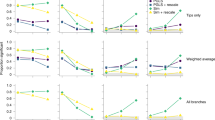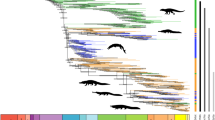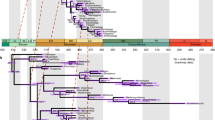Abstract
Morphological diversity tends to increase within evolving lineages over time1,2, but the relative roles of gradual evolutionary change (anagenesis)3 and abrupt shifts associated with speciation events (cladogenesis, or ‘punctuated equilibrium’)4 have not been resolved for most groups of organisms5. However, these two modes of evolution can be distinguished by the fact that morphological variance increases in proportion to time under anagenesis6, and in proportion to the logarithm of the number of species under cladogenesis7. Although species and time are themselves correlated, multiple regression analysis provides a statistical framework for partitioning their relative contributions. In this study, I use multiple regressions to evaluate the effects of time and species number on morphological diversity within clades of passerine birds. The results show clearly that number of species exerts a strong influence on morphological variance independent of time, but that time has no unique effect. Thus, morphological evolution in birds seems to be associated with cladogenesis. How lineage splitting promotes morphological diversification poses an important challenge to ecologists and evolutionary biologists.
This is a preview of subscription content, access via your institution
Access options
Subscribe to this journal
Receive 51 print issues and online access
$199.00 per year
only $3.90 per issue
Buy this article
- Purchase on Springer Link
- Instant access to full article PDF
Prices may be subject to local taxes which are calculated during checkout


Similar content being viewed by others
References
Foote, M. The evolution of morphological diversity. Annu. Rev. Ecol. Syst. 28, 129–152 (1997)
Harmon, L. J., Schulte, J. A. II, Larson, A. & Losos, J. B. Tempo and mode of evolutionary radiation in iguanian lizards. Science 301, 961–964 (2003)
Simpson, G. G. The Major Features of Evolution (Columbia Univ. Press, New York, 1953)
Gould, S. J. & Eldredge, N. Punctuated equilibria: the tempo and mode of evolution reconsidered. Paleobiology 3, 115–151 (1977)
Jackson, J. B. C. & Cheetham, A. H. Tempo and mode of speciation in the sea. Trends Ecol. Evol. 14, 72–77 (1999)
Raup, D. M. & Gould, S. J. Stochastic simulation and evolution of morphology–towards a nomothetic paleontology. Syst. Zool. 23, 305–322 (1974)
Foote, M. in Evolutionary Paleobiology (eds Jablonski, D., Erwin, D. H. & Lipps, J. H.) 62–86 (Univ. Chicago Press, Chicago, 1996)
Miles, D. B. & Ricklefs, R. E. The correlation between ecology and morphology in deciduous forest passerine birds. Ecology 65, 1629–1640 (1984)
Ricklefs, R. E. & Miles, D. B. in Ecological Morphology. Integrative Organismal Biology (eds Wainwright, P. C. & Reilly, S. M.) 13–41 (Univ. Chicago Press, Chicago, 1994)
Ricklefs, R. E. & Travis, J. A morphological approach to the study of avian community organization. Auk 97, 321–338 (1980)
Benkman, C. W. Divergent selection drives the adaptive radiation of crossbills. Evolution 57, 1176–1181 (2003)
Moritz, C., Patton, J. L., Schneider, C. J. & Smith, T. B. Diversification of rainforest faunas: an integrated molecular approach. Annu. Rev. Ecol. Syst. 31, 533–563 (2000)
Schluter, D. Morphological and phylogenetic relations among the Darwin's finches. Evolution 38, 921–930 (1984)
Lack, D. Darwin's Finches (Cambridge Univ. Press, Cambridge, 1947)
Grant, P. R. Convergent and divergent character displacement. Biol. J. Linn. Soc. 4, 39–68 (1972)
Schluter, D. Character displacement and the adaptive divergence of finches on islands and continents. Am. Nat. 131, 799–824 (1988)
Schluter, D. Ecological causes of adaptive radiation. Am. Nat. 148, S40–S64 (1996)
Lovette, I. J., Bermingham, E. & Ricklefs, R. E. Clade-specific morphological diversification and adaptive radiation in Hawaiian songbirds. Proc. R. Soc. Lond. B 269, 37–42 (2002)
Schluter, D. The Ecology of Adaptive Radiation (Oxford Univ. Press, Oxford, 2000)
Ricklefs, R. E. Global diversification rates of passerine birds. Proc. R. Soc. Lond. B 270, 2285–2291 (2003)
Eldredge, N. & Gould, S. J. in Models in Paleobiology (ed. Schopf, T. J. M.) 82–115 (Freeman, San Francisco, 1972)
Carson, H. L. & Templeton, A. R. Genetic revolutions in relation to speciation phenomena: the founding of new populations. Annu. Rev. Ecol. Syst. 15, 97–131 (1984)
Sibley, C. G. & Monroe, B. L. Jr. Distribution and Taxonomy of Birds of the World (Yale Univ. Press, New Haven, Connecticut, 1990)
Sibley, C. G. & Ahlquist, J. E. Phylogeny and Classification of the Birds of the World (Yale Univ. Press, New Haven, Connecticut, 1990)
Abouheif, E. A method to test the assumption of phylogenetic independence in comparative data. Evol. Ecol. Res. 1, 895–909 (1999)
Legendre, P. & Legendre, L. Numerical Ecology (Elsevier, Amsterdam, 1998)
Acknowledgements
I thank M. Foote, T. Givnish and S. S. Renner for constructive comments. For access to specimens, I am grateful to curators and collection managers at the Academy of Natural Sciences in Philadelphia, the US National museum, the American Museum of Natural History, the Field Museum in Chicago, the Bavarian State Collections in Munich, the Senckenberg Museum in Frankfurt and the Museum des Sciences Naturelles in Brussels. This work was supported in part by research funds available to Curators’ Professors at the University of Missouri.
Author information
Authors and Affiliations
Corresponding author
Ethics declarations
Competing interests
The authors declare that they have no competing financial interests.
Supplementary information
Supplementary Table 1
The 106 suprageneric clades of passerine birds used in analyses of morphological diversification as a function of time and species number. (DOC 254 kb)
Supplementary Table 2
List of clades having less than 10 species and used in an analysis of the effects of continental versus non-continental distribution and degree of sympatry on morphological variance. (DOC 56 kb)
Rights and permissions
About this article
Cite this article
Ricklefs, R. Cladogenesis and morphological diversification in passerine birds. Nature 430, 338–341 (2004). https://doi.org/10.1038/nature02700
Received:
Accepted:
Issue Date:
DOI: https://doi.org/10.1038/nature02700
This article is cited by
-
Heterogeneous relationships between rates of speciation and body size evolution across vertebrate clades
Nature Ecology & Evolution (2020)
-
Comparison of head size and bite force in two sister species of parrotbills
Avian Research (2018)
-
Disparity and Evolutionary Rate Do Not Explain Diversity Patterns in Muroid Rodents (Rodentia: Muroidea)
Evolutionary Biology (2018)
-
Rates of morphological evolution, asymmetry and morphological integration of shell shape in scallops
BMC Evolutionary Biology (2017)
-
Phylogenetic analyses suggest that diversification and body size evolution are independent in insects
BMC Evolutionary Biology (2016)
Comments
By submitting a comment you agree to abide by our Terms and Community Guidelines. If you find something abusive or that does not comply with our terms or guidelines please flag it as inappropriate.



